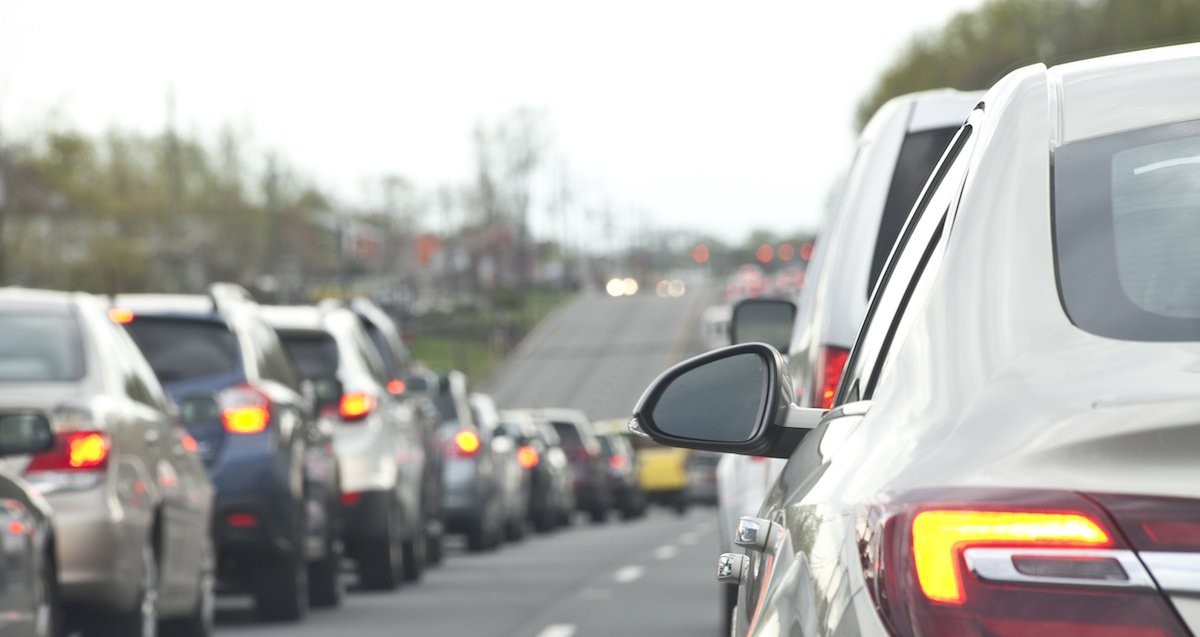
As Brampton grapples with its transportation future, can it escape its past?
It’s early morning and the whop-whop-whop sound from a traffic helicopter fills the blue-grey skies over Brampton.
From the cockpit, the traffic reporter directs his eyes at the 410 south and a giant conga line of traffic that’s snapping shut like an old Slinky toy. The blur of cars that to the eye becomes a constant line has almost reached an important nexus as some lanes continue south to the 403 and others split off to feed the east and west on-ramps to the 401. Later in the afternoon, this traffic pattern will reverse itself.
But right now, no one is moving.
The radio voice in the chopper reports that a blue SUV and a white panel truck are wedged together after a minor fender-bender and sit just off the left guardrail as three police cars and two tow trucks surround them. The other cars, SUVs, vans, pickups and 16-wheelers idle uneasily as an MTO crew cleans up a small oil spill that has brought all forward movement to a stop. He suggests radio listeners seek alternative routes: Tomken, Kennedy, Hurontario, maybe even McLaughlin Road.
In 2019, rush hour is not a rush and lasts longer than an hour. Commutes that were once sprints, are now marathons, and traffic from side streets and arterial roads pump even more plaque into the city’s congested circulatory system.
The 410 widening began in 2014 and ended in 2018 and has thinned some of the once-God awful volume, but the vagaries of weather and even a minor fender-bender can turn daily commutes into soul-destroying slowdowns. It’s still awful.
The traffic flow on the 410 confirms each day what has been known for years: Brampton is built for traffic.
The numbers are unsettling. The city sheds its skin each morning as more than 150,000 citizens exit – a number agreed upon by Statistics Canada, Brampton’s 2040 Vision, the Economic Development Master Plan, and a Transportation Tomorrow Survey taken in 2016.
This mass exodus is biblical in size and driven by pure economics. The 63.7 percent who leave do so to work outside the city. And the vast majority (90 percent) don’t use public transit. There’s another price to be paid for this because the city roads feeding into the provincial 400-series highway system have to be built and maintained. A two percent levy was pasted onto this year’s budget and will be attached to the next year and the years after that to pay for infrastructure shortfalls.
Brampton mayor Patrick Brown has vowed to build up a business base that has for years lagged far behind its sister city Mississauga, which checks in with 62,000 businesses, 73 Fortune 500 companies, and 1,400 multinational firms. Once very much like us, an exporter of traffic, it is now a net importer of jobs.
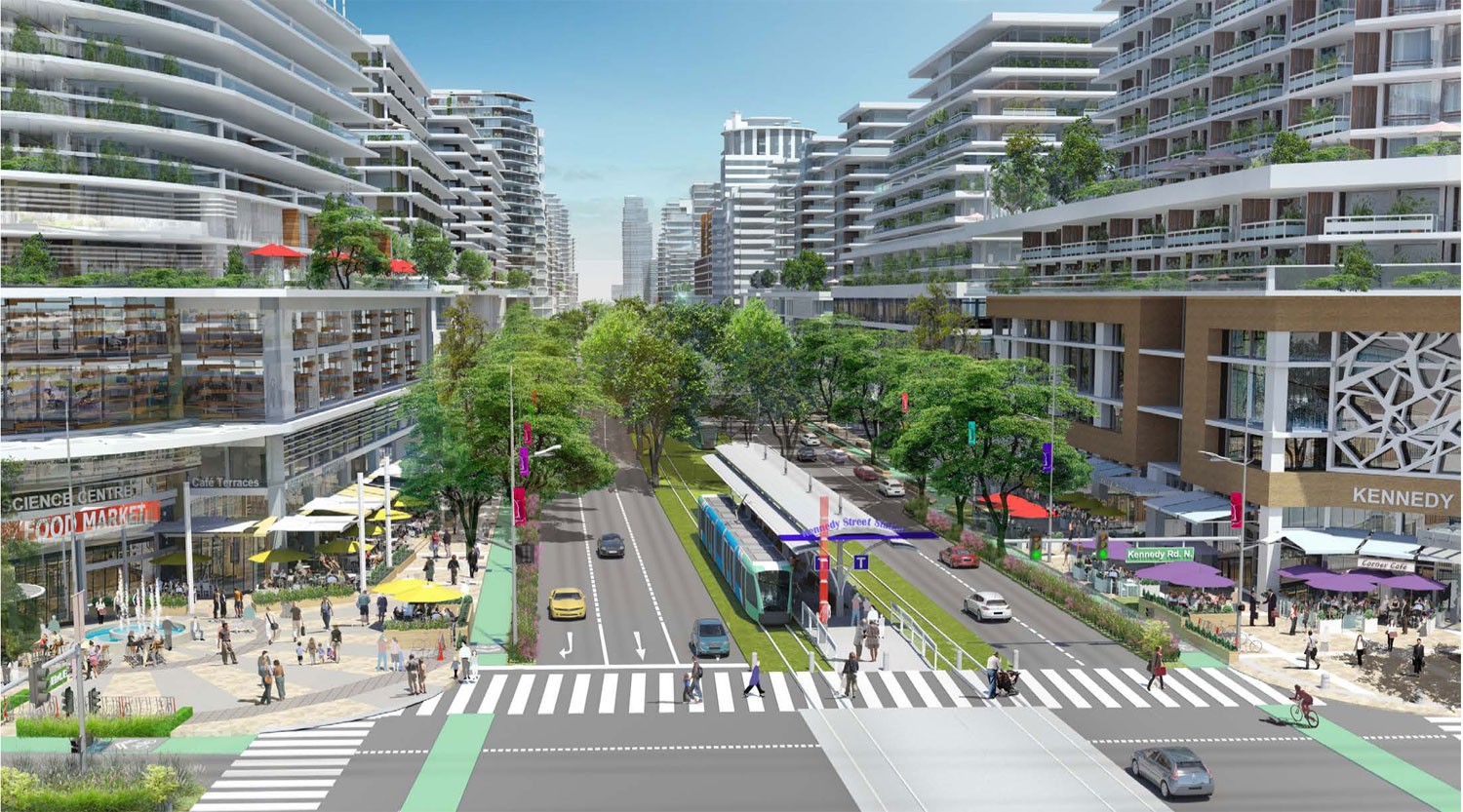
A rendering of the city's 2040 Vision plan
Today, Saturday, City Hall is hosting a lengthy series of talks and presentations called A Community in Action. The event, to engage residents about the future of “active transportation” in Brampton will attempt to grapple with big-picture issues that will either set the course for a less car-dependent, future-ready way of moving people; or, if ideas being implemented around the world get rejected here, a future that will be more of the same, just worse. It began at 9 a.m. and continues till 4 p.m..
No doubt, Brown’s game plan will take time – and might meet with mixed success.
How to move people (and product) is a complex issue that requires a comprehensive set of actions and changes in behavior that will have to be inputted now, and over the next few years, says Bruce Zvaniga, Brampton’s commissioner of public works and engineering.
Has the Ministry of Transportation (MTO) done the city any favours in completing its massive expansion of the 410, completing the city’s give-over to the car? And now, with the Ford government putting a new GTA-west 400-series highway back on the planning table, after the previous Liberal government dropped it, citing poor environmental, land-use and transportation design issues as the reason why, is it more proof that leaders seem to talk out of both sides of their mouth when it comes to smart transportation? Brown is one of those supporting the move to get the new highway built.
But many planners and environmentalists simply don’t buy the argument that Brampton can build itself out of gridlock. They also question if focusing on major road infrastructure for a mix of traffic, is the best way to move goods, with more cars and trucks competing for limited space.
Zvaniga says developing “complete communities” (those that live, work, play and shop within close proximity of each other) promotes walking, cycling and transit as viable alternatives to driving a vehicle. Traffic is really a land-use question and City Hall is committed to driving up densities with new mixed-use developments in both residential and commercial. This, says Zvaniga, leads to shorter trips which also encourages getting around without the car.
Canadians use of public transit hovers around 12 percent, up two points from 1996. Those numbers are fluffed up by large, high-density cities like Toronto, Montreal and Vancouver, with plenty of public transit offerings, according to StatsCan.
Other numbers (while some are almost a decade old) are still striking:
• of the 10.6 million workers who commuted by car, about 9 million reported that they had never used public transit, and 7.4 million think public transit would be somewhat or very inconvenient;
• about 1.6 million car commuters (15 percent) said they tried using it, but more than half (53 percent) found it inconvenient – mostly because it takes longer; and
• the longest average daily commute time in North America, according to a global survey released in 2018 by the company Expert Market, is in the GTA, 96 minutes, both ways, the sixth worst of 74 major cities around the world included in the study.
But those numbers would be driven down by inner-city residents with easy access to an extensive network of buses, streetcars, and subways. It’s likely that many Brampton commuters spend even more time each day stuck in their cars, losing productivity and personal time for more than two hours a day.
Canada’s car-dependent city
It might be argued Brampton is the most car-dependent big city in Canada. If traffic simply left town, it wouldn’t be so bad, but these commuters buy gas, visit restaurants, and shop. Those economic losses are immeasurable.
Brampton’s dependence on the car seems fuelled by geography, and its limited transit options. How bad is it?
Start with this riddle: How long would it take a car-less couple living on a side street in the northwestern corner of this city to get to work in downtown Toronto via public transit? The first issue is finding a bus. Side streets offer limited service, or none at all. Once on the bus, the couple transfers to another, and takes it to one of the three GO stations. The long ride to Union Station, which can be anywhere from 34 minutes to an hour and ten minutes, depending on the station and the time of day, is followed by a bus, subway or streetcar, which gets them to their final destination. There’s one more complication: Brampton is the only major city in the GTA not serviced by all-day, two-way GO Train service. Our commuters are chained to the limited GO train schedule, a further disincentive to ride the rails. In all, transit calculators peg many total trip times, including the walk from a home and wait times for onboarding from a Brampton residence in one of the city’s bulging subdivisions to some popular employment areas in Toronto at between one hour and forty minutes and two hours and twenty minutes, approximately, each way. Is it realistic to expect people to eschew the car, when this is the alternative?
City of Brampton staff tells The Pointer that higher order transit (ZUM, bus rapid transit, light rail and commuter rail) is a convenient and integrated way to commute – more efficient than driving. But that model is not available here. A potential multi-billion-dollar light rail line scheduled to be built up Hurontario and link this city to all-day GO service from the Port Credit station, has been pared back by a cost-cutting Doug Ford regime. There is no guaranteed date for the build to start, which is now set to end at Steeles Avenue. Though the new Brampton City Council has reversed a decision by the last group to scrap the LRT’s extension into downtown along Main Street, there is currently no funding commitment for a plan that would likely cost about $400 million as a surface route, but as much as $1.7 billion if part of it has to go underground, which is what council, on Brown’s urging, is considering. Even a figure somewhere in the middle represents an amount that would be difficult to fund, given the current fiscal realities facing both the city and the province. It could be a long time before an LRT comes through Brampton.
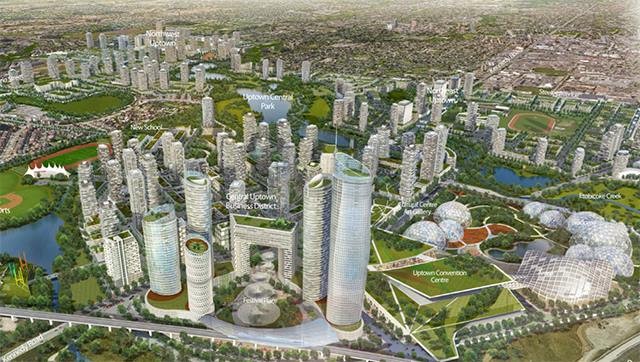
The high density plan of the 2040 Vision
Brampton’s aspirations are defined in its 2040 Vision, a master plan cobbled together by urban planner Larry Beasley of Vancouver, with input from more than 13,000 citizens. It is a main focus of today’s public event at City Hall. Not surprisingly, the first vision in the final report was transportation. The hope is everything will be connected by a transit network to a new core loop, possibly a figure eight of rapid transit ringing the broader central area of the city, while walking and cycling networks abound, with wider sidewalks, a virtual network, and new travel technologies leading the way. A fully functional regional rapid transit network would be bolstered with incentives to use the system. There’s little mention of the car, but when it arises, rides are shared, with infrastructure and incentives to eliminate single-occupancy commuter vehicles, making traffic impacts minimal. A Traffic Management Advisory Board would rule over this organic whole.
When it comes to commuting, schedule reliability and frequency are key, City staff tells The Pointer. Fostering the use of transit as an element of Mobility as a Service (MaaS) system, allows users to select the transportation modes that are best suited for their trips. This all has to be seamless. Many of those transit hopes were discussed at the ITAC Smart City Forum held earlier this year at Brampton’s Rose Theatre. The transportation experts who spoke, said implementation of region-wide, interconnected networks with single-card use for payment, and high-speed, futuristic vehicles to travel on, will, it’s hoped, break commuters’ dependence on the car.
The view from the traffic chopper is striking, maybe a little dystopian, but there are also urban planners who think the war on the car is being overstated. American authors Robert Bruegmann (Sprawl: A Compact History) and William Bogart (Don’t Call It Sprawl) have been joined at times, by those closer to home, like Toronto’s Joe Berridge, a partner with Toronto-based Urban Strategies. He’s the author of a new book, Perfect City: An Urban Fixer’s Global Search for Magic in the Modern Metropolis. Berridge isn’t some car-hating greenie, who casts out dire warnings like Hef, the ruler of Helheim in Norse mythology.
His planning orthodoxy has settled over time, and was on display a few years back when he wrote a magazine piece entitled: 'Suburbia Forever: Canadians like living with sprawl’. He dissected Bogart’s theorem, and offered up his opinion on the province’s Places to Grow legislation, which more than a decade ago set the legislative guidelines for minimizing sprawl across much of Southern Ontario. He said if sprawl is so bad, why do over 100,000 new arrivers settle into the GTA each year, or why will 3.5 million gravitate to the Greater Golden Horseshoe over the next two decades? His premise is that people don’t put themselves into situations that are beyond what’s acceptable to them.
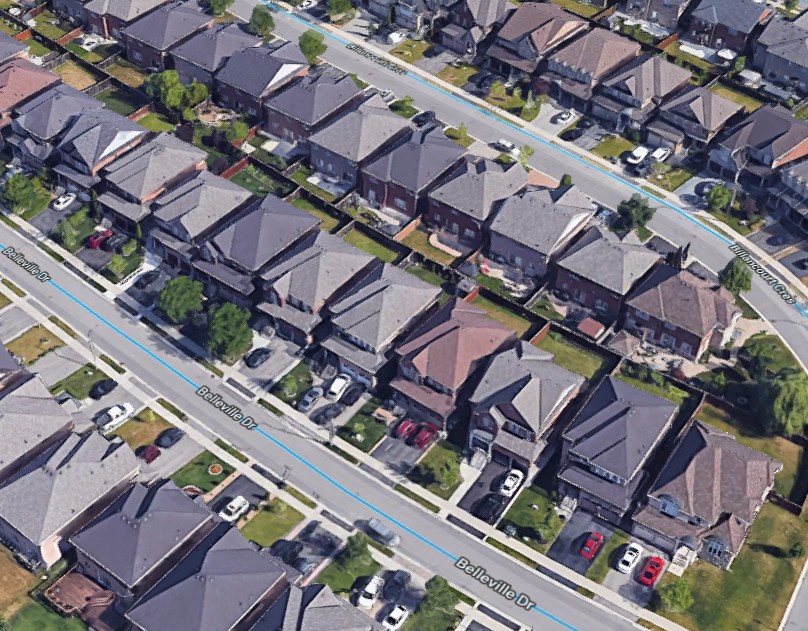
A Google image of a Brampton subdivision
Berridge said there is no survey that shows citizens in the ‘burbs are any less happy than inner-city dwellers’. He argues that cities are simply a physical expression of a certain majority’s preferences, and by global standards, the GTA is a more compact hub than North American markets like Atlanta, Denver, Washington, Chicago and Los Angeles. Meaning: the GTA is actually under-served by its freeways. Those aren’t exactly the models many other global cities aspire to follow. The car-dominated American urban planning model of the post-war age is widely considered a disastrous contribution to land-use, personal-time planning, economic productivity and environmental stewardship. The exhaust filled air above those cities, choking people even more as commute times get longer, is a by-product of the two industries that have pushed bad planning that’s dependent on cars: the global auto-sector and the big carbon emitting oil companies, both of which have exerted tremendous influence over politicians who have pushed suburban-style land-use and transportation design.
But Berridge also loves the Places to Grow legislation. Like Bogart, he thinks cities will eventually find their natural, more compact form. The current transit fix – buses, subways, GO Train lines, LRT – is a “flat” solution, and future transit initiatives should be based wholly on demand, not supply, he says.
The car: a history
The tight cityscapes that were defined by foot traffic in the Greco-Roman times, morphed into medieval settlements connected by horses and carts. In the early 20th-century streetcars and cars and the Manhattanizing of city building was ushered in, but the vast majority of residents didn’t live in the cities and suburbs awaiting the post-war boom. That changed everything. The next generation, the boomers, embraced the suburban ideal: house, big lawn, two cars, and little public transit usage. In New York City, the powerbroker wasn’t a politico but an urban designer named Robert Moses, a master city builder, or neighbourhood destroyer – depending on your viewpoint.
His plans to carve super expressways through NYC and leave ugly scars through organic street life, met head on with a critic named Jane Jacobs. She changed the urban outlook in profound ways in the second half of the 20thcentury. She is remembered in lore for standing up to Moses, and even throwing herself in front of a bulldozer to stop another freeway. When she moved to Toronto in the early 1970s, she took on another monster: the development community. She helped lead the fight to kill the Spadina Expressway. She didn’t have to stand in front of bulldozers this time – metaphorically speaking, William G. Davis did it for her.
The Brampton-born former premier changed history. On June 3, 1971, Davis rose in the provincial legislature and said: “Cities were built for people and not cars. If we are building a transportation system to serve the automobile, the Spadina Expressway would be a good place to start. But if we are building a transportation system to serve people, the Spadina Expressway is a good place to stop.”

Bill Davis shakes hands with former Ontario PC leader Tim Hudak
Davis checked his political ideology at the door of the legislature and found a compromise between so-called progress and city building. Two decades later, the same PC party ushered “gridlock” and “sprawl” into our lexicon. And two decades after the Mike Harris and Ernie Eves premierships, the GTA is now one of the five most congested regions in North America, driving hard to be number two behind Los Angeles. The Toronto Transit Commission (TTC), once a forward-thinking marvel and world wonder, is now a joke, bloated, slow, inefficient and costly. It built a subway line to nowhere, and has been ineffective in demanding LRT lines and subways that could fundamentally change the flow of movement across the entire GTA. Now another PC party is back in power and returning to the 1990s model of city building.
They’ve turned the high beams off on sprawl, and have embraced its twin sister, traffic. Sweeping legislation from the Doug Ford regime could revert back to the old Ontario Municipal Board system of developer-driven decision making, clawing away at laws on environmental protection, heritage, planning and smart land use, after the OMB was dismantled by the previous government in favour of a land-use oversight body that took decision-making away from developers and gave it back to municipalities. The idea is to build homes, with more density and to use land wisely, in a more compact form that can connect people using transit, instead of the sprawling single-family houses that make subdivision dwellers entirely reliant on cars to get anywhere.
But Ford is moving the GTA, particularly the 905, back to that old model. The plan is to get more houses onto the market and reduce the skyrocketing costs that developers claim is driven by a lack of supply. The result of their desire to keep slapping up sprawling subdivisions on land developers bought decades ago, and are now desperate to cash in on (while aggressively fighting to stop smart-growth planning that could see much of their land speculation plays result in unused space they would have to take a loss on) will be more traffic. Thousands of vehicles. Is this a commitment to help solve the housing shortage, as Ford contends, or as other critics suspect, a simple giveaway to his developer friends – people he promised to help after being caught on tape expressing that opinion to them during last year’s election campaign?
His reversion to the old OMB model has been widely criticized as a clear giveaway to the development industry Ford has remained close with.
Yes, this will be a boon to automakers and road builders. The GTA West Corridor, a future 400-series highway has been proposed to run through Caledon and south into the western side of Brampton on its way to the 401. It would be a gift to the developers, who claim it will speed up the movement of people. It would also shift the 2040 Vision plan for smart, dense growth in urban nodes throughout Brampton to sprawling future subdivisions along the edges of the city where developers long ago gobbled up land and began pushing for their development.
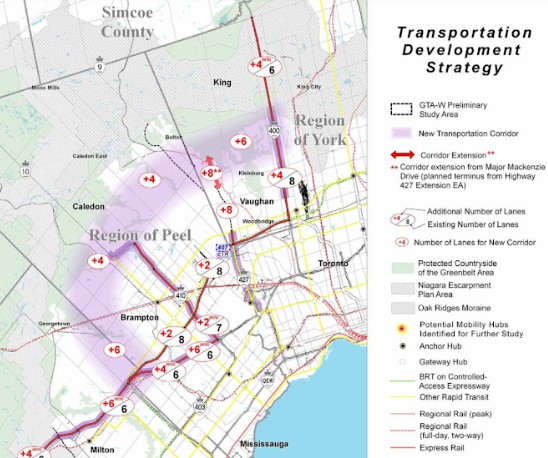
A map of the proposed GTA West Highway corridor
Last fall, the City of Brampton hit the pause button on efforts to turn over all that land for more sprawling subdivisions, with an entire review of its planning and land-use policy to align with the smart-growth ideal of the 2040 Vision. But that was all done under the previous council. Brown seems to be talking out of both sides of his mouth, calling for smart growth and making claims of leading a future-ready movement for Brampton, while supporting the GTA West Highway idea and not staking out a clear position on the land-use review. Will he turn his back on the developers screaming that any turn-around of the land-use plan, in favour of more dense design, would cost them a fortune? Or will he support their efforts to create more sprawl and traffic chaos?
The Ford government moved late last year to open up development in The Greenbelt, which stirred up a firestorm of public protests, which caused him to back off. But it’s clear, he wants to change the rules, and continue the type of land use that will guarantee traffic will only get worse, while making it even harder to design public transit networks that only work in more compact urban forms.
The Liberal government of Dalton McGuinty reined in land use excess that moved people farther and farther away and its Places to Grow and Greenbelt legislation kicked off a 14-year period of “smart growth” thinking. It directly targeted communities like Brampton, and put a governor on the building of single-family homes and the escalation in traffic that developers here, and friendly city councillors, pushed for decades.
We are now staring at a back to the future solution, with Ford running headlong into the “Enigma” generation, the millennials whom studies have shown, don’t like cars and prefer to use public transit so they can live closer to where they work and play. Building new highways might offer them and us a short-term respite, but it creates even more societal chaos down the road – not even taking into consideration the ecological damage.
The GTA West Corridor (initially proposed by the Kathleen Wynne Liberals) would carry 300,000 cars and trucks per day by 2031, and ease the average commute time that is projected to increase by 27 minutes a decade from now.
Jane Jacobs is gone, but her status as an urban icon and unrepentant battler lives on. Davis is the long-retired ex-premier whose easy style of leadership and middle-of-the-road compromises has now divorced from the alt-right party of Ford.
The Places to Grow legislation created smart growth and saw former sprawlers like Mississauga and Brampton begin the process of building up (or in Brampton’s case, it slowed the process of building out).
This week, Berridge unveiled his new book, talking about Perfect Cities, the ones around the world that got development and political governance right. He also appeared on Steve Paiken’s The Agenda on TVO, and will act as a keynote speaker at the 2019 Land & Development Conference in Toronto near the end of this month.
Bill Davis is long retired and living out the rest of his fruitful life at his home in Brampton. During his retirement, he won The Jane Jacobs Lifetime Achievement Award, given to a person who has made an extraordinary contribution to the public realm over the years. His stand to stop the Spadina Expressway is one of the great moments in his 14-year run as premier.
That said, Canadians still love their cars. Even though a recent study by Angus Reid Global says that 96 percent of the time, cars don’t guzzle gas, but money. The study sampled over 2,000 Canadians who said they are behind the wheel of their car for just 380 hours per year, while it sits idle for the other 8,380 hours. It also confirms that the country is still a car-culture with 84 percent ownership – although 68 percent of the 18-34 age group remain car free. Almost half of Canadians said they would have to change jobs if they didn’t own a car.
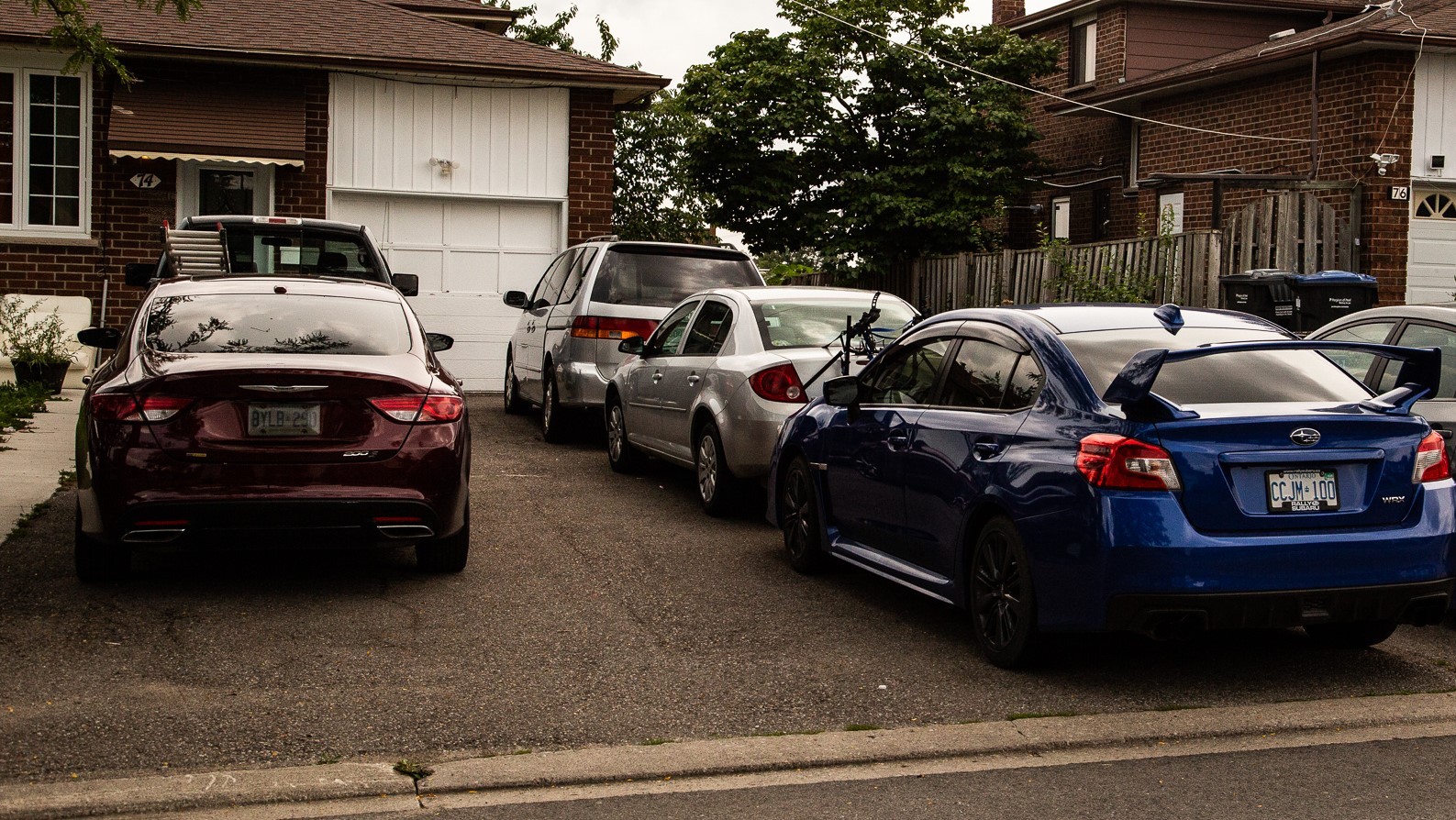
Brampton showed a dramatic uptick in transit usage in 2017 and ’18, up a full 18 and 14 percent respectively. This is considerable, since the national average is 1.5 percent. But it’s still a drop in the bucket and the city is hardly the composite drawing of a city that has embraced new modes of transport. The sharp transit-usage increases reflect a system that has been woefully inadequate and is still far behind other similar-sized cities in Canada in terms of overall ridership and average transit usage.
But if more investment is made in the city’s transit system, those numbers could continue to climb. But at some point, once those forced or easily convinced to use transit, have the service they desire, any future growth will depend on getting car-lovers to change their ways.
Zvaniga points to research suggesting the most effective time to change a person’s choice of travel mode is when they move to a new home or a new job location. He said, “once someone makes the decision to buy a vehicle to serve the home-to-work trip because cycling, walking or transit are not viable modes, it can be difficult to change their behaviour.
Car owners don’t begrudge spending for fuel, maintenance and insurance because, unlike transit, [this] payment isn't required before the start of each car trip. The perceived cost of driving is often far lower than the actual total cost of use and ownership.”
Brampton is yearning for traffic solutions. The expansion of the 410 is stop-gap, and including new HOV lanes at least helps to break single-rider car usage.
The news that young Canadians aren’t as ‘car crazy’ as earlier generations, and don’t drive as much, is heartening for those who believe the environmental, economic, and psychic costs of grinding gridlock is just too much to bear.
But according to DesRosiers Automotive Consultants, car ownership rates across Canada are soaring, including a startling increase in the number of young people (aged 35 and under) who are getting their driver’s license. Many are signing up to drive and for much longer distances.
Yes, the 410 is as busy as ever, a constant stream of vehicles, and a virtual parking lot during rush hours – especially when the weather turns bad, or a fender bender brings everyone to a stop.
Even though they might not be as in love with the car, it looks like millennials won’t be able to kill the dependence, at least not in the near future.
In a place like Brampton, if most residents, political leaders and the development industry continue to enable policies that keep people in their cars, even those fighting for change might be the ones caught in that roadway jam reported everyday by the traffic chopper.
Submit a correction about this story


